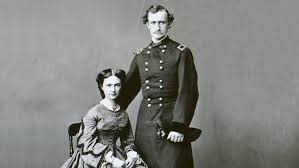Enter now for a chance to win None Wounded, None Missing, All Dead:
The Story of Elizabeth Bacon Custer.
On June 27, 1876, Captain Frederick William Benteen spotted a cluster of white objects lying in a heap on a hill north of the Bighorn River in southern Montana. Benteen, a 42-year old career Army officer with a shock of white hair combed dramatically back over his long, bare forehead and harassed face, urged his horse slowly toward the knoll. A party of dutiful soldiers followed along behind him, their angry silence filled the air. As Captain Benteen inched his horse cautiously onto the site it became clear that the achromatic objects lying motionless in the tall grass were the remains of General George Custer* and his regiment. The flesh and bones of 210 members of the 7th Cavalry lay strewn over a mile of bloody ground. All of the bodies except for General Custer’s had been stripped naked and were mutilated.
Captain Benteen climbed down off his horse and made his way to General Custer’s body, stepping over dead soldiers pierced by arrows and lances in the process. George Custer’s ghostly frame was riddled with a number of injuries, not the least of which was a gunshot wound to the left flank and left temple. Benteen studied the bodies around him noticing that not only did the Indians in the fight leave George’s remains in tact, but left his socks on his feet. They had not scalped him either – his short, wavy hair was undisturbed.
“There he is, God damn him,” Benteen said coldly to members of his battalion now digging graves to bury the dead. “He’ll never fight anymore.” Benteen had known the popular boy General for more than ten years and he never liked him. He thought George was overly proud and impulsive. The Captain removed a piece of paper and the stub of a pencil from a pocket on his uniform, wrote George’s name on it, and nailed it to the wooden stake marking the spot where the General fell. “I went over the battlefield carefully with a view to determine how the fight was fought,” a distressed Benteen wrote in a report two days after the conflict. “I arrived at the conclusion I have right now – that it was a rout, a panic, till the last man was killed…. George himself was responsible for the Little Big Horn action, and it is an injustice to attribute the blame to anyone else.” Benteen had been in George’s command and ordered to reinforce his beleaguered troops at the Battle of Little Big Horn. For reasons that would be debated the rest of his life, Benteen did not come to George’s aide.
During the battle, Elizabeth Bacon Custer was only a few hundred miles away, in the Dakota Territory, waiting bravely for news of the expedition. The escalation of the Great Sioux War had brought the 7th Cavalry to the frontier, and where George went, Elizabeth followed.
One of the most charming and controversial soldiers the country ever produced, George Armstrong Custer and his equally delightful and charming bride, were devoted to one another and valued the time they spent together in the field and at their never-permanent homes at various Army post. Many times, Elizabeth lived in tents alongside members of the 7th Cavalry.
Over the twelve years the Custers were together, Elizabeth had lived history. She and George honeymooned in the war zones of the waning years of the Civil Way, and she witnessed the surrender of Robert E. Lee at Appomattox Courthouse and later was given the table at which the terms of surrender were signed. After the Civil War, when George’s regiment was sent to Texas to facilitate Reconstruction and then to the plains states as an “Indian Fighter” Elizabeth began her life on the frontier and experienced the most thrilling events of her life, an adventure that lasted until the memorable day when Custer and his troops made their immortal last stand against the Sioux Indians.
To learn more about Elizabeth Bacon Custer and her marriage to George Armstrong Custer read None Wounded, None Missing, All Dead:
The Story of Elizabeth Bacon Custer.


